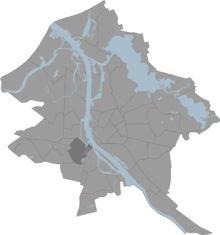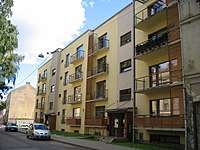Āgenskalns
Āgenskalns (historically known also as Hāgenskalns or Hagensberg) is a district in Riga, located on the left bank of the Daugava, an old neighbourhood, mainly built in the late 19th to early 20th century. The total area of Agenskalns is 4,6 km2, which is a lot less than other districts of Riga.

History
First known building of Agenskalns and whole Pardaugava was the fortified Mara mill, which was mentioned already in 1226. As evidenced by maps of the 17th century, the village of Agenskalns started next to crossroads of current Meza, Setas and Nometnu Street and continued to develop alongside Nometnu Street.[1] During the 17th century, Agenskalns was little populated. Most of the non-auxiliary members of the Latvian trade house dominated there and also mercenaries - fishermen, anchors, wine barrel carriers, boatmen and others.
Name “Agenskalns” came from a manor of Henrih fon Hagen, who was a judge in the 17th century (german Hagenshof, nowadays known as Švarcmuiža),[2] and who was the owner of lands alongside Rankas dam and Kuldigas Street. During the Great Northern War, Agenskalns was destroyed, but later restored.
During the French invasion of Russia, in fear of Napoleon's troops, all the buildings of Agenskalns were burned down, so the buildings that are there nowadays started to develop on the first half of the 19th century. The layout of buildings was made without a certain plan and that is why street network between Nometnu and Eduarda Smilga Street is quite chaotic. Nowadays this territory is a national monument of urban construction and is known for its great wooden architecture.[3]

Architecture
Oldest building in Agenskalns is the Hartmann manor,[4] located in Kalnciema street 28/30. Agenskalns is a vivid example of Art Nouveau and German Balts architectural symbiosis. One of the best examples of this is the water tower of Agenskalns, which was projected by Wilhelm Bockslaff and built in 1910. – entrance of the water tower is decorated with various geometric ornaments that end with a triangular timpanon; other Art Nouveau features can also be seen there (stylized imperial eagle etc.).[5] In the nearby Margrietas street you can find one of Mikhail Eisenstein projected buildings, which shows a strong influence of historicism. In Agenskalns there are many residential and commercial houses, which have been built in the 19th and 20th century, where you can find the influence of Art Nouveau. One of the most prominent Art Nouveau complexes is the Market of Agenskalns, which was built after a project of Reinhold Schmaeling,[6] current Market building was built from 1911 until 1924. Pauls Stradins Clinical University Hospital was also built after one of his project and is located in Agenskalns, Pilsona Street 13. Other mentionable Art Nouveau features can be found in Arcadia Park, made after a project of Georg Kuphaldt in 1910.
Notable places in Agenskalns
- Agenskalns Market - Built in 1911 – 1914
- Railroad Museum - Uzvaras Boulevard 2/4
- Eduards Smilgis Theatre Museum - E. Smilga (Dartas) Street 37/39
- Uzvaras park
- Hotel Janne building
- Radisson SAS Hotel Riga
- Maritim Park Hotel Riga
- Janis Akuraters museum - O. Vaciesa Street 6a
- Ojars Vacietis museum - O. Vaciesa Street 19
- Pauls Stradins Clinical University Hospital - Pilsoņu Street 13, built in 1908 - 1910
Schools
- University of Latvia Faculty of Physics and Mathematics
- Riga Technical University Faculty of Engineering Economics and Management; Faculty of Computer Science and Information Technology
- University of Business, Arts and Technology
- Rīga 14. vakara vidusskola
- Rīga 34. arodvidusskolas filiāle
- Rīgas 53. vidusskola
- Rīgas 61. vidusskola
- Āgenskalna Valsts ģimnāzija
- Rīgas Valsts vācu ģimnāzija
- Emīls Dārziņš Music School
- Friča Brīvzemnieka pamatskola
- Horeogrāfijas vidusskola
- Rīgas Katoļu ģimnāzija
- Rīgas valdorfskola
References
- Blūms, Pēteris (2001). Pārdaugava — Terra Trans Dunam // Koka Rīga. Neptuns.
- "Āgenskalns :: Vietas.lv". Vietas.lv - Latvijas ceļvedis, Latvijas karte, pilsētas, rajoni, tūrisma un citi interesanti objekti, pasākumi. Retrieved 2018-02-10.
- http://www.citariga.lv, CitaRiga. "Agenskalns :: Other Riga". Cita Rīga (in Latvian). Retrieved 2018-02-10.
- "The new building of Hartmann manor, Kalnciema 30". www.ambermarks.com. Retrieved 2018-02-10.
- "Āgenskalns Water Tower | Sightseeing | Riga". www.inyourpocket.com. Retrieved 2018-02-10.
- Ojārs. "Reinhold Georg Schmaeling (1840–1917) – Riga City Architect (1879–1915)". arhitekts.riga.lv. Retrieved 2018-02-10.